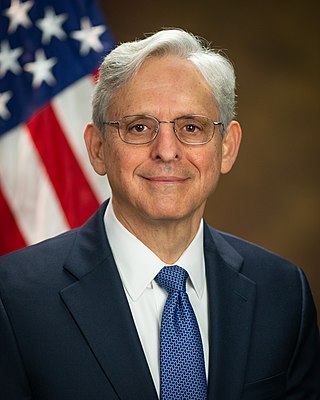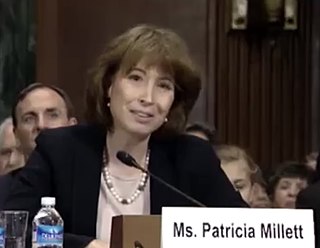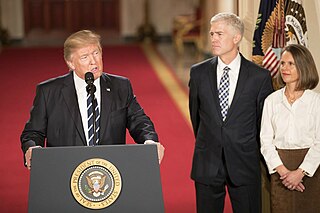
The Supreme Court of the United States is the highest-ranking judicial body in the United States. Established by Article III of the Constitution, the detailed structure of the court was laid down by the 1st United States Congress in 1789. Congress specified the Court's original and appellate jurisdiction, created 13 judicial districts, and fixed the initial size of the Supreme Court. The number of justices on the Supreme Court changed six times before settling at the present total of nine in 1869. As of June 2022, a total of 116 justices have served on the Supreme Court since 1789. Justices have life tenure, and so they serve until they die in office, resign or retire, or are impeached and removed from office.

Merrick Brian Garland is an American lawyer and jurist who serves as the 86th United States attorney general. He previously served as a U.S. circuit judge of the United States Court of Appeals for the District of Columbia Circuit from 1997 to 2021. In 2016, President Barack Obama nominated Garland to the U.S. Supreme Court, but the Republican-led U.S. Senate effectively blocked Garland's appointment.

Speculation abounded over potential nominations to the Supreme Court of the United States by President George W. Bush since before his presidency.
In the United States Senate, the nuclear option is a parliamentary procedure that allows the Senate to override a standing rule by a simple majority, avoiding the two-thirds supermajority normally required to invoke cloture on a measure amending the Standing Rules. The term "nuclear option" is an analogy to nuclear weapons being the most extreme option in warfare.
The Gang of 14 was a bipartisan group of Senators in the 109th United States Congress who successfully, at the time, negotiated a compromise in the spring of 2005 to avoid the deployment of the so-called "nuclear option" by Senate Republican Majority over an organized use of the filibuster by Senate Democrats.
Advice and consent is an English phrase frequently used in enacting formulae of bills and in other legal or constitutional contexts. It describes either of two situations: where a weak executive branch of a government enacts something previously approved of by the legislative branch or where the legislative branch concurs and approves something previously enacted by a strong executive branch.

Richard Allen Griffin is a United States circuit judge of the United States Court of Appeals for the Sixth Circuit. Previously, he was a judge on the Michigan Court of Appeals.
Paul Steven Diamond is a United States district judge of the United States District Court for the Eastern District of Pennsylvania and a former federal judicial nominee to be a judge on the United States Court of Appeals for the Third Circuit. He was appointed a federal judge by George W. Bush in 2004.

Patricia Ann Millett is a United States circuit judge of the United States Court of Appeals for the District of Columbia Circuit. She formerly headed the Supreme Court practice at the law firm Akin Gump Strauss Hauer & Feld. Millett also was a longtime former assistant to the United States Solicitor General and served as an occasional blogger for SCOTUSblog. At the time of her confirmation to the D.C. Circuit, she had argued 32 cases before the United States Supreme Court. In February 2016 The New York Times identified her as a potential nominee to replace Justice Antonin Scalia.
During his two terms in office, President Dwight D. Eisenhower nominated five members for the Supreme Court of the United States: Chief Justice Earl Warren, and Associate Justices John Marshall Harlan II, William Brennan, Charles Evans Whittaker, and Potter Stewart. All were confirmed by the Senate.

The nomination and confirmation of justices to the Supreme Court of the United States involves several steps, the framework for which is set forth in the United States Constitution. Specifically, Article II, Section 2, Clause 2, provides that the president of the United States nominates a justice and that the United States Senate provides advice and consent before the person is formally appointed to the Court. It also empowers a president to temporarily, under certain circumstances, fill a Supreme Court vacancy by means of a recess appointment. The Constitution does not set any qualifications for service as a justice, thus the president may nominate any individual to serve on the Court.
U.S. President Barack Obama nominated over 400 individuals for federal judgeships during his presidency. Of these nominations, Congress confirmed 329 judgeships, 173 during the 111th & 112th Congresses and 156 during the 113th and 114th Congresses.

Joan Louise Larsen is an American attorney serving as a United States circuit judge of the United States Court of Appeals for the Sixth Circuit. She previously was an associate justice of the Michigan Supreme Court from 2015 to 2017.

On March 16, 2016, President Barack Obama nominated Merrick Garland for Associate Justice of the Supreme Court of the United States to succeed Antonin Scalia, who had died one month earlier. At the time of his nomination, Garland was the chief judge of the United States Court of Appeals for the District of Columbia Circuit.

On January 31, 2017, soon after taking office, President Donald Trump, a Republican, nominated Neil Gorsuch for Associate Justice of the Supreme Court of the United States to succeed Antonin Scalia, who had died almost one year earlier. Then-president Barack Obama, a Democrat, nominated Merrick Garland to succeed Scalia on March 16, 2016, but the Republican-controlled U.S. Senate did not vote on the nomination. Majority leader Mitch McConnell declared that as the presidential election cycle had already commenced, it made the appointment of the next justice a political issue to be decided by voters. The Senate Judiciary Committee refused to consider the Garland nomination, thus keeping the vacancy open through the end of Obama's presidency on January 20, 2017.
Donald Trump, President of the United States from 2017 to 2021, entered office with a significant number of judicial vacancies, including a Supreme Court vacancy due to the death of Antonin Scalia in February 2016. During the first eight months of his presidency, he nominated approximately 50 judges, a significantly higher number than any other recent president had made by that point in his presidency. By June 24, 2020, 200 of his Article III nominees had been confirmed by the United States Senate. According to multiple media outlets, Trump significantly impacted the composition of the Supreme Court and lower courts during his tenure.

On September 26, 2020, President Donald Trump announced the nomination of Amy Coney Barrett to the position of Associate Justice of the Supreme Court of the United States to fill in the vacancy left by the death of Ruth Bader Ginsburg. At the time of her nomination, Barrett was a Judge of the United States Court of Appeals for the Seventh Circuit in Chicago, Illinois. The Senate received word from the president on September 29.

On February 25, 2022, President Joe Biden announced that he would nominate Ketanji Brown Jackson to the position of associate justice of the Supreme Court of the United States to fill the vacancy by Stephen Breyer, who announced his retirement on January 27, 2022, at the age of 83. Jackson, a former law clerk of Breyer, was a judge on the United States Court of Appeals for the District of Columbia Circuit, having been appointed by Biden in 2021. Jackson is the first Black woman in U.S. history to be nominated to serve on the U.S. Supreme Court.

Louis Brandeis was nominated to serve as an associate justice of the Supreme Court of the United States by U.S. President Woodrow Wilson on January 28, 1916, after the death in office of Joseph Rucker Lamar created a vacancy on the Supreme Court. Per the Constitution of the United States, Brandeis' nomination was subject to the advice and consent of the United States Senate, which holds the determinant power to confirm or reject nominations to the U.S. Supreme Court.

Thurgood Marshall was nominated to serve as an associate justice of the Supreme Court of the United States by U.S. President Lyndon B. Johnson on June 13, 1967 to fill the seat being vacated by Tom C. Clark. Per the Constitution of the United States, the nomination was subject to the advice and consent of the United States Senate, which holds the determinant power to confirm or reject nominations to the U.S. Supreme Court. Marshall was confirmed by the U.S. Senate in a 69–11 vote on August 30, 1967, becoming the first African American member of the Court, and the court's first non-white justice.













